Geraniums are not just flowers; they are a gardener’s delight and a splash of cheer in any garden or windowsill.
As an avid gardening enthusiast, I’ve had my fair share of experiences with various plants, but geraniums hold a special place in my heart. Their vibrant colors and ease of care make them a favorite for both beginners and seasoned gardeners.
In this article, I’ll share my insights on why these charming plants are a must-have in your garden and some of my favorite varieties that have never failed to impress.
Benefits of Growing Geraniums
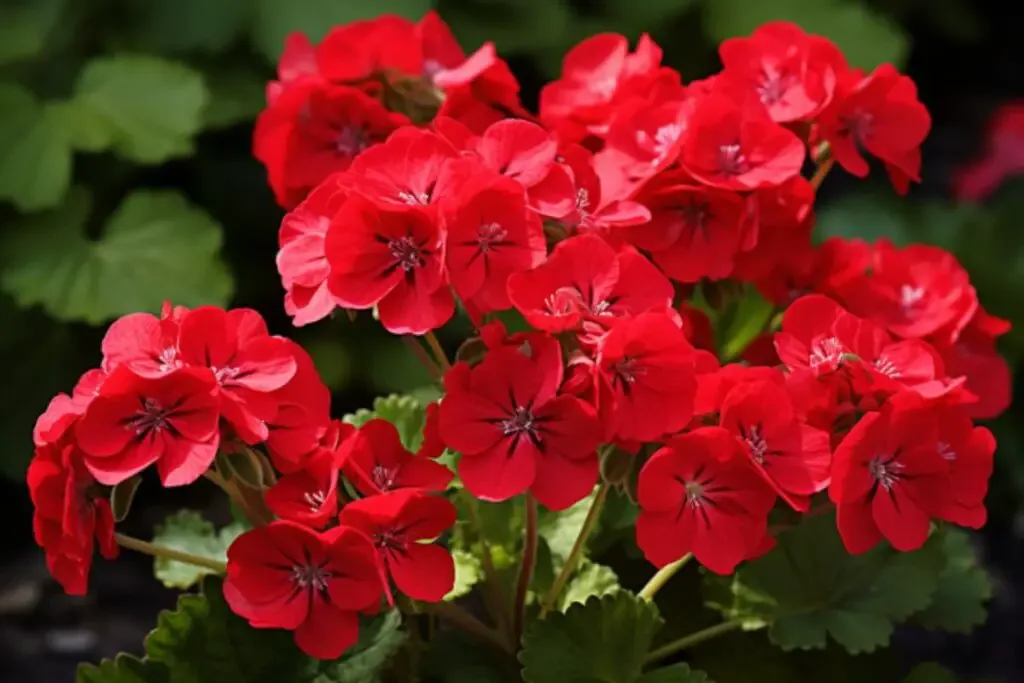
1. Vibrant and Long-Lasting Blooms
One of the most striking benefits of geraniums is their ability to brighten up any space with their vivid flowers. Whether it’s the classic reds, soft pinks, or even the more unusual purples and blues, geraniums offer a wide range of colors.
What’s more, they bloom from spring right through to the first frost, providing a long-lasting display of beauty.
2. Low Maintenance and Drought Tolerant
For those of you who love plants but have a busy schedule, geraniums are a godsend. They require minimal care and are quite forgiving if you forget to water them occasionally.
Their drought tolerance makes them ideal for areas with water restrictions or for gardeners who prefer plants that don’t need constant attention.
3. Versatile and Adaptable
Geraniums are incredibly versatile. You can grow them in garden beds, hanging baskets, or containers. They adapt well to various growing conditions, whether it’s a sunny windowsill or a partially shaded spot in your yard.
This adaptability makes them suitable for gardeners in a variety of climates and with different space constraints.
My Favorite Geranium Varieties
As a gardening enthusiast, I’ve experimented with numerous geranium varieties over the years. While each has its unique charm, there are a few that have truly captured my heart with their distinctive characteristics.
Here are my top three picks:
1. Zonal Geraniums (Pelargonium x hortorum)
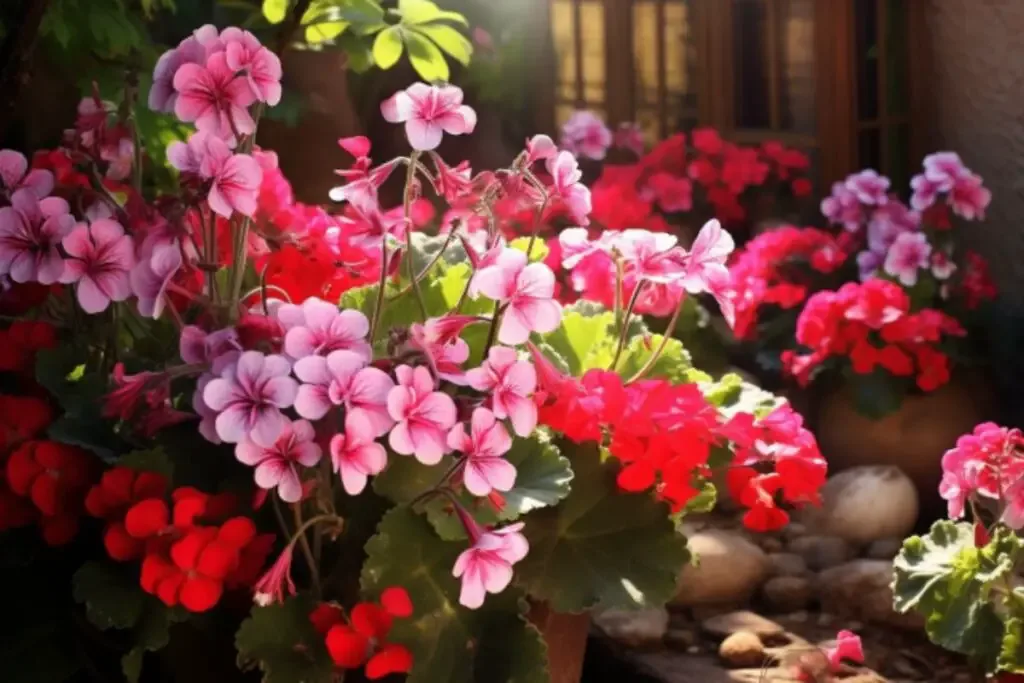
These are the classic, robust geraniums that most people recognize. Known for their large, bright blooms and zoned foliage, these plants are perfect for adding a pop of color to any setting.
I particularly love the ‘Calliope Dark Red’ variety for its stunning, deep red flowers that seem to glow against the lush green leaves.
2. Ivy Geraniums (Pelargonium peltatum)
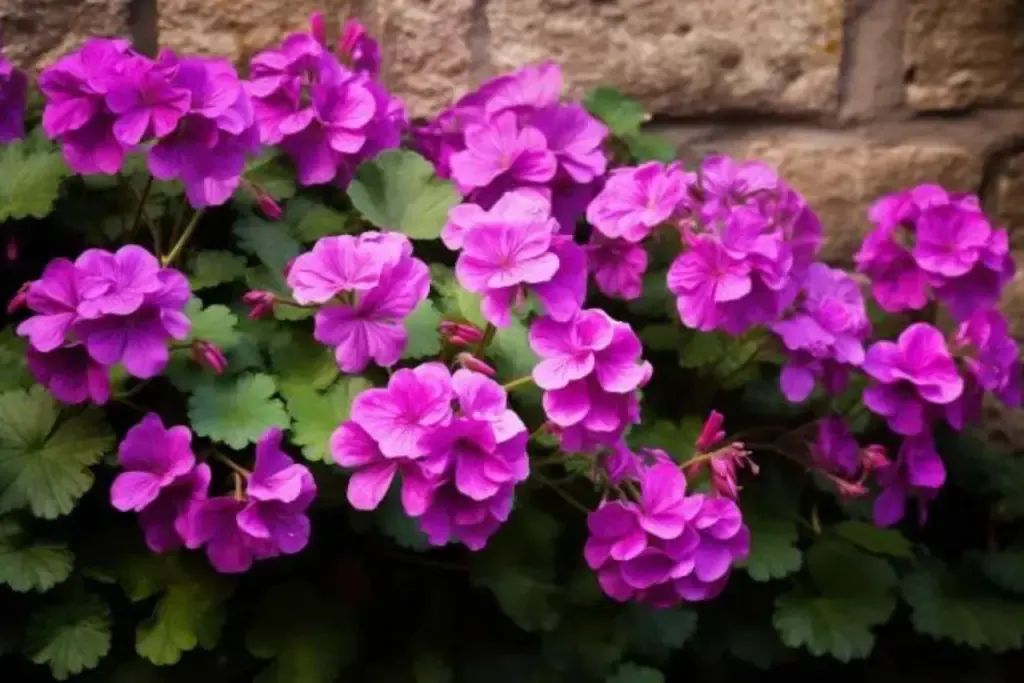
For those who love trailing plants, ivy geraniums are a dream. With their cascading growth habit, they are perfect for hanging baskets or as a spilling plant in container gardens.
The ‘Global Stars and Stripes’ variety is a personal favorite with its unique patterned petals – white with red stripes, adding a whimsical touch to any garden.
3. Scented Geraniums (Pelargonium spp.)
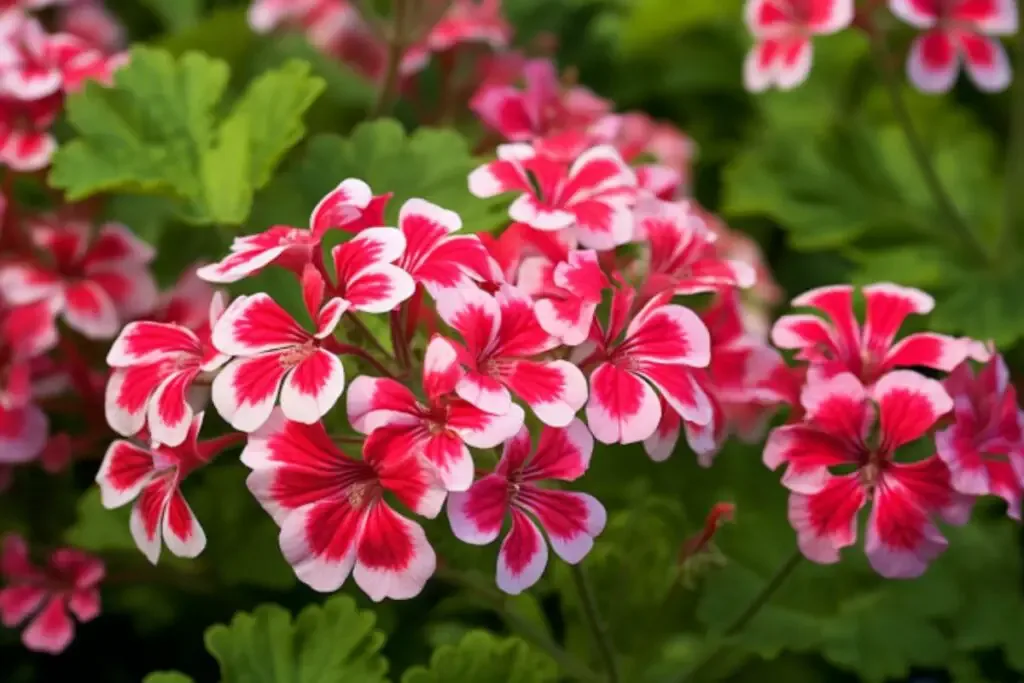
Not just a feast for the eyes, scented geraniums also tantalize the senses with fragrant leaves. The scents range from rose to lemon, and even chocolate!
My top choice in this category is the ‘Rose-Scented Geranium’ for its lovely aroma that reminds me of a fresh rose garden. These are great not only for their visual appeal but also for adding a pleasant fragrance to your home or garden.
Geranium Care
Caring for geraniums is a rewarding experience, especially when you see them bloom in all their glory. These plants are not only beautiful but also quite resilient, making them a favorite among gardeners of all levels.
Here are some key tips on how to provide the best care for your geraniums, ensuring they stay healthy and vibrant.
Planting
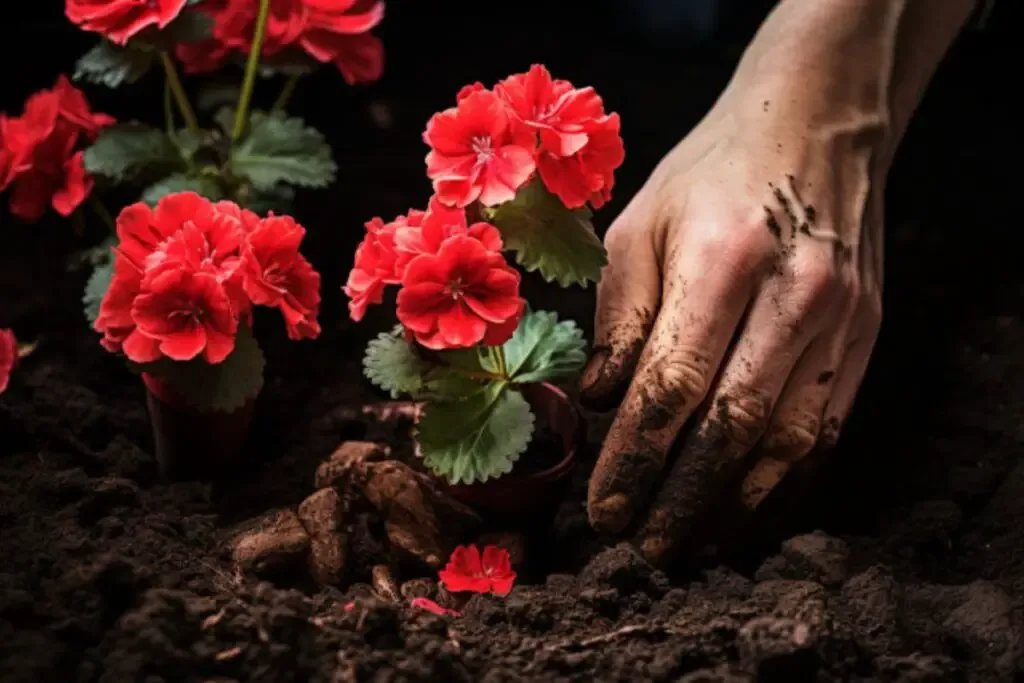
Planting geraniums is a fun and creative process. These plants are incredibly versatile and can be introduced into your garden or home in various ways. Whether you’re planting them in the ground, in pots, or as part of a larger garden design, here are some tips to get the best results.
- Sunlight is Crucial: Choose a location for your geraniums that gets ample sunlight, as they thrive best in sunny conditions.
- Soil Preparation: For garden planting, enrich the soil with compost or organic matter for better drainage and nutrients. In containers, use a high-quality potting mix.
- Proper Planting Technique: Plant geraniums at the same depth as their container and space them about 6 to 12 inches apart. This ensures good growth and air circulation.
- Initial Watering: Water your geraniums thoroughly right after planting to settle the soil around the roots and remove air pockets.
- Companion Planting: Pair geraniums with other sun-loving plants like petunias and lavender for a beautiful and beneficial garden arrangement.
Light
Geraniums love the sun! Ideally, they should receive about six to eight hours of sunlight per day.
If you’re growing them indoors, a south-facing window is a great spot. For outdoor gardens, ensure they’re in a place where they can bask in ample sunlight.
However, in extremely hot climates, a bit of afternoon shade can prevent them from getting scorched.
Soil
The right soil is crucial for the health and growth of geraniums. They require well-draining soil that doesn’t retain too much moisture, as this can lead to root rot. A mix that is rich in organic matter is ideal, as it provides the necessary nutrients while ensuring proper drainage.
For container-grown geraniums, a high-quality potting mix specifically designed for container plants works best. Additionally, geraniums prefer a slightly acidic to neutral soil pH, typically between 6.0 and 7.0.
Regular soil testing and amendments can help maintain the optimal soil conditions for your geraniums to thrive.
Water
Proper watering is key to the health of geraniums. They prefer a balance, requiring consistent moisture but not over-saturation. Allow the soil to dry slightly between waterings, as geraniums are prone to root rot in overly wet conditions.
During the growing season, watering them once every couple of days may be necessary, especially in hotter climates. In cooler temperatures or when grown indoors, reducing the frequency to once a week or when the top inch of the soil feels dry is usually adequate.
It’s important to avoid waterlogging, particularly for container-grown geraniums, ensuring that pots have good drainage.
Temperature and Humidity
Geraniums flourish in moderate temperatures, ideally between 65°F and 75°F, but can struggle in extreme heat or cold. They are not frost-tolerant and should be brought indoors or protected when temperatures approach freezing.
In hot climates, providing afternoon shade and adequate water can help them manage temperatures above 85°F. While they can handle a range of humidity levels, maintaining moderate humidity with good air circulation is important to prevent fungal diseases.
Proper temperature and humidity management is crucial for the health and vibrancy of geraniums.
Fertilizer
Fertilizing geraniums correctly is essential for promoting vigorous growth and abundant blooming. Here are some key points:
- Type of Fertilizer: Use a water-soluble fertilizer that’s balanced or one with a slightly higher phosphorus content (indicated by the middle number in the fertilizer ratio) to encourage blooming. A formula like 10-10-10 or 15-30-15 works well.
- Frequency of Application: During the growing season (spring and summer), fertilize geraniums every two to four weeks. This regular feeding schedule supports continuous growth and flowering.
- Over-Fertilizing Caution: Avoid over-fertilizing as it can lead to lush foliage at the expense of flowers. Excessive fertilizer can also build up in the soil, potentially harming the plant.
- Application Method: When applying fertilizer, follow the instructions on the package for proper dilution and application. Ensure even distribution around the plant and avoid getting fertilizer on the foliage to prevent burn.
Pruning
Effective pruning is essential for the health and aesthetics of geraniums. Here are five key steps:
- Timing: Prune in early spring and again in mid-summer to encourage bushier growth and more blooms.
- Deadheading: Regularly remove spent flowers to promote continuous blooming.
- Removing Yellow Leaves: Cut off any yellowing or dead leaves to maintain plant health and appearance.
- Shaping: Pinch back stem tips to encourage a denser, more compact plant shape.
- Winter Preparation: If overwintering indoors, prune back the plants by about one-third before moving them inside.
Propagating
Propagating geraniums is a simple and effective way to create new plants. Here are four key steps:
- Select Healthy Stems: Choose healthy, non-flowering stems for cuttings, about 4-6 inches in length.
- Prepare Cuttings: Remove the lower leaves and optionally dip the cut end into rooting hormone.
- Plant in Soil: Plant the cuttings in moist, well-draining potting soil, ensuring at least one node is buried.
- Provide Proper Conditions: Keep the soil moist and place the cuttings in a warm, bright area until roots develop.
How to Grow Geraniums From Seed
Growing geraniums from seed can be a rewarding experience. Here’s a concise guide in four steps:
- Start Indoors: Begin 8-10 weeks before the last frost date. Sow seeds in a sterile seed-starting mix, lightly covering them.
- Provide Light and Warmth: Geranium seeds need light to germinate, so place them in a bright spot or under grow lights. Maintain a temperature around 75°F.
- Water Carefully: Keep the soil moist but not waterlogged. Use a spray bottle to gently water without disturbing the seeds.
- Transplant Seedlings: Once they have a few true leaves, transplant them into individual pots. Harden off before moving outdoors after the frost risk has passed.
Growing in Pots
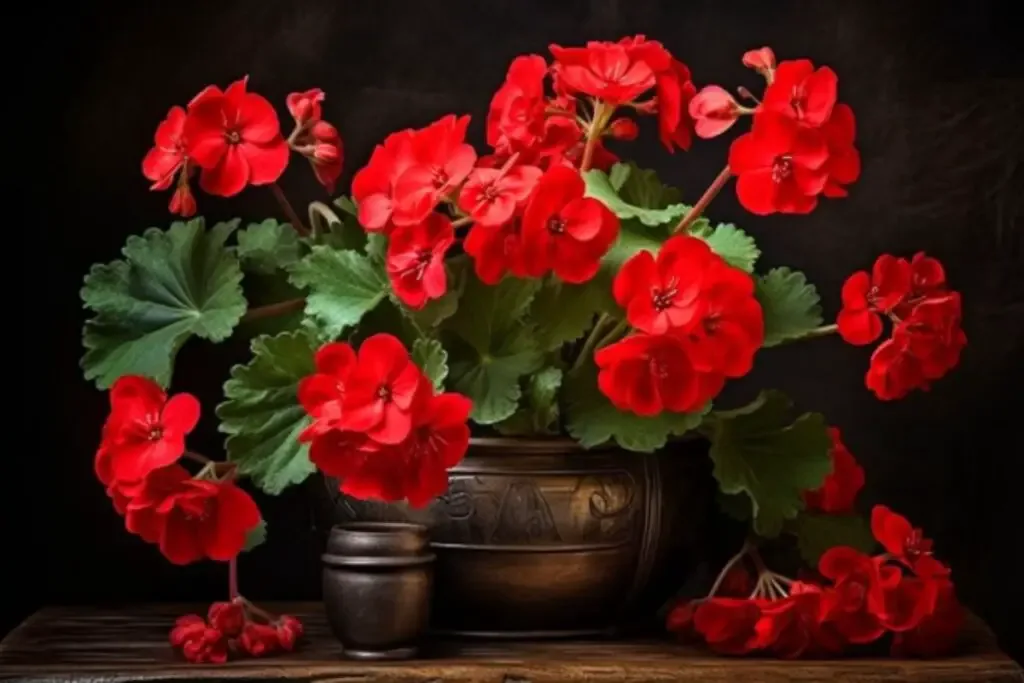
Growing geraniums in pots is a great way to enjoy these vibrant plants in limited spaces. Here are four essential tips:
- Suitable Pots: Choose pots with adequate drainage holes to prevent waterlogging. The size should accommodate the plant’s root system, typically 12-16 inches in diameter.
- Potting Mix: Use a high-quality, well-draining potting mix. Geraniums do not thrive in heavy, compact soil.
- Sunlight and Location: Place the pots in a location with about six to eight hours of sunlight daily. Ensure they are protected from extreme heat or cold.
- Regular Watering and Fertilizing: Water when the top inch of soil dries out. Use a balanced, water-soluble fertilizer every two to four weeks during the growing season.
Overwintering
Overwintering geraniums allows you to preserve your plants through the cold season. Here are four key steps:
- Pre-Frost Preparation: Before the first frost, bring outdoor geraniums indoors or move potted plants to a sheltered location.
- Pruning: Trim the plants back by about one-third to manage size and encourage new growth in spring.
- Reduced Watering and Fertilization: Water sparingly during winter, allowing the soil to dry out between waterings. Suspend fertilization until spring.
- Proper Location: Keep the geraniums in a cool, well-lit area, such as near a south-facing window, to provide enough light without excessive heat.
Transplanting
Transplanting geraniums can give them a fresh start in a new location or pot. Here are four essential steps for successful transplanting:
- Best Time to Transplant: Choose early spring or late summer when the plant is not in full bloom for less stress on the geranium.
- Preparing the New Site: Whether it’s a new pot or a garden spot, ensure it has well-draining soil and receives adequate sunlight.
- Gentle Removal: Carefully remove the geranium from its current location, trying to keep the root ball intact to minimize root damage.
- Replanting: Plant the geranium at the same depth it was growing previously. Water thoroughly after transplanting to settle the soil and reduce transplant shock.
Common Pests & Diseases
Geraniums, like all plants, are susceptible to certain pests and diseases. Here are four common ones to watch out for:
- Aphids: These small, green, or black insects feed on the sap of the plants, causing the leaves to curl and become distorted. They can be controlled with insecticidal soap or neem oil.
- Whiteflies: These tiny white flying insects cluster on the undersides of leaves, sucking plant juices and causing yellowing. Use yellow sticky traps and insecticidal soaps for control.
- Botrytis Blight: A fungal disease that causes gray mold on leaves, stems, and flowers, especially in humid conditions. Improve air circulation and reduce humidity to prevent it. Infected parts should be removed and destroyed.
- Rust: Appearing as small, rust-colored spots on the undersides of leaves, this fungal disease can weaken plants. To manage rust, remove affected leaves and avoid overhead watering. Fungicides can be used for severe cases.
Whether you’re a seasoned gardener or just starting out, geraniums are a delightful addition to any garden or home. With their vibrant blooms and relatively easy care, they offer endless possibilities for beautification and enjoyment.
By understanding their needs and watching out for common pests and diseases, you can ensure your geraniums thrive and bring color and life to your space. Remember, gardening is not just about the plants; it’s about the joy and relaxation it brings to you. Happy gardening!

